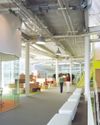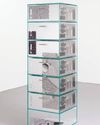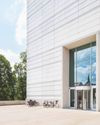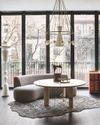The blob ostensibly obliterated the culture of tectonics within architecture, but it was a short-lived fad. Interest has shifted again toward a loosely “aformal” approach —the pile. What are the consequences of architects

“Architects tend to be idealists, and not dialecticians,” Robert Smithson once said. The artist, best known for his earthworks in which raw dirt and industrial materials collided, often in acts of smothering and commingling, accretion and dissolution, had an uneasy relationship with architects. “They never seem to allow for any kind of relationship outside of their grand plan.” Speaking to an actual architect, Alison Sky of SITE, Smithson riffed on the idea of an “entropic architecture” to describe a work site in Central Park he had seen: a vast pit shored up by scaffolding. It should have stayed, he thought.
On the face of it, Smithson’s cosmic position seems untenable for architects. Entropy is an ineluctable fact, but it is easily deferred; other considerations—professional codes of safety, programmatic desiderata—necessarily come first. It doesn’t help that entropic effects occur at a register at odds with our own faulty spatiotemporal antennae. The human animal has great difficulty reconciling cosmic laws with the finitude of everyday experience, and architects are as bad at this as everyone else.
But it is also clear that Smithson’s put-down is dated, and so packs far less punch. Architects are more than capable of thinking dialectically—that is to say, processually—as this group clearly illustrates. These designers share an admiration for Smithson’s primitivist art and that of his fellow traffickers in the archaic, Michael Heizer and Richard Serra. Among them, an expanded definition of form is a given. Technical virtuosity, after a decade of “digital jisms” (in critic Rowan Moore’s memorable epithet), is viewed with suspicion. They are experimental about materials. The catchall “pile” is frequently invoked, both as metaphor and typology, noun and verb, base and superstructure.
This story is from the September 2017 edition of Metropolis Magazine.
Start your 7-day Magzter GOLD free trial to access thousands of curated premium stories, and 9,000+ magazines and newspapers.
Already a subscriber ? Sign In
This story is from the September 2017 edition of Metropolis Magazine.
Start your 7-day Magzter GOLD free trial to access thousands of curated premium stories, and 9,000+ magazines and newspapers.
Already a subscriber? Sign In

No New Buildings
The energy already embodied in the built environment is a precious unnatural resource. It’s time to start treating it like one.

The Circular Office
Major manufacturers are exploring every avenue to close the loop on workplace furniture.

Signs of Life
Designers, curators, and entrepreneurs are scrambling to make sense of motherhood in a culture that’s often hostile to it.

Interspecies Ethic
In probing the relationship between humans and nature, two major exhibitions question the very foundations of design practice.

Building on Brand
The Bauhaus turned 100 this year, and a crop of museum buildings sprang up for the celebration.

Building for Tomorrow, Today
Radical change in the building industry is desperately needed. And it cannot happen without the building trades.

Strength from Within
Maggie’s Centres, the service-focused cancer support network, eschews clinical design to arm patients in their fight for life.

Next-Level Living
The availability of attractive, hospitality-grade products on the market means everyday consumers can live the high life at home.

Mi Casa, Su Casa
Casa Perfect creates a memorable shopping experience in lavish private homes.

Enter The Culinarium
AvroKO imagines the future of residential amenities—where convenience, comfort, and sustainability meet.